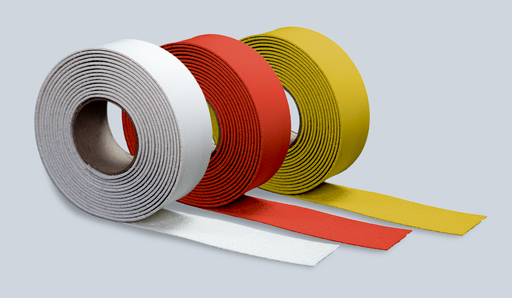When it comes to road marking projects, choosing the right product for line application can make a significant difference in efficiency, cost, and ease of installation. Two common options in the road marking industry are 5-metre rolls of lines and boxes of 1-metre strips of pre-formed thermoplastic markings. While both are highly durable and designed for road safety applications, they serve different purposes depending on the scope and nature of the project.
In this post, we’ll compare these two options—5-metre rolls and 1-metre strips—highlighting their advantages, disadvantages, and best use cases.

1. Ease of Application
5-Metre Rolls: One of the biggest advantages of 5-metre rolls is their efficiency in application. These rolls are ideal for marking longer stretches, such as lane dividers or edge lines. By using rolls, you can cover significant lengths of road quickly, reducing the time spent on installation. The fewer interruptions you have, the faster and more seamless the application process. By using fewer, longer lines, it's also easier to ensure the finished result is a straight as possible.
- Best for: Long, straight roads like highways, main streets, and industrial zones.
- Installation: Rolls are unrolled in place and heated to adhere to the road surface in one continuous motion, minimising the need for precise alignment every metre.
1-Metre Strips: On the other hand, boxes of 1-metre strips are more versatile for areas that require frequent starts and stops, such as intersections, tight corners, or spaces with a lot of detail work. The shorter strips allow for more precise placement and are easier to adjust, making them perfect for areas with complex layouts where flexibility is key.
- Best for: Small, detailed areas like pedestrian crossings, parking lots, and intersections.
- Installation: Each 1-metre strip must be laid individually, which can require more time and attention to alignment, but this also allows for better control over the exact placement.
2. Project Scope and Scale
5-Metre Rolls: For large-scale projects, such as roads and pedestrian streets, 5-metre rolls are typically more practical. They cover more ground in less time, making them ideal for projects with tight deadlines or limited opportunity for road closures. Using long rolls reduces the number of joints, leading to a more streamlined appearance and less wear over time.
- Ideal for: Large roadways, highways, and commercial zones where uninterrupted line markings are necessary.
- Efficiency: With fewer pieces to work with, larger projects are completed faster, reducing the overall labour costs.
1-Metre Strips: For smaller or more detailed projects, the 1-metre strips offer more flexibility and control. Since each strip is shorter, they are easier to fit into smaller spaces or irregular layouts. These strips are perfect for areas where precision is more important than speed, such as parking lots, intersections, or micromobility lanes like bike and scooter paths.
- Ideal for: Smaller projects or areas with complex designs such as parking spaces, pedestrian zones, or areas with multiple curves.
- Efficiency: Though it takes longer to install each metre, the ability to position each strip exactly where it’s needed can reduce the chance of mistakes or misalignment.

3. Cost-Effectiveness
5-Metre Rolls: While rolls of road lines and boxed lines are pretty comparable in terms of price, rolls often save money in labour costs. The reduced installation time and fewer interruptions can result in significant cost savings for larger projects. Additionally, the continuous application means fewer seams between strips, reducing potential future maintenance needs.
- Cost per metre: Rolls generally have a lower cost per metre when considering the speed of installation and the reduction in labour costs.
1-Metre Strips: Boxes of 1-metre strips are often more affordable upfront but can be more expensive in terms of installation time, especially on larger projects. However, for small-scale or intricate projects, the cost of the strips may balance out with the precision and control they offer.
- Cost per metre: The initial cost per metre may be lower than rolls, but additional labour costs may increase the overall expense for larger projects.
4. Durability and Performance
Both 5-metre rolls and 1-metre strips are made from durable thermoplastic materials designed to withstand heavy traffic, weather, and wear. The key difference lies in the number of joints created during installation.
5-Metre Rolls: With fewer seams, rolls provide a more continuous surface, which can lead to longer-lasting performance. Fewer seams also mean fewer points where dirt, moisture, or other elements can weaken the line over time.
- Durability: More seamless, resulting in a longer lifespan and reduced maintenance.
1-Metre Strips: Since 1-metre strips are applied in shorter sections, more seams are created. While this doesn’t significantly affect the performance of the material, it can lead to slightly more wear over time, especially in high-traffic areas where seams might come under more stress.
- Durability: Slightly more seams mean more potential points for wear, but performance remains strong for most applications.

5. Best Use Cases
5-Metre Rolls:
- Long roadways
- Highways and main streets
- Industrial areas with continuous traffic lines
- Parking bays
- Pedestrian areas
1-Metre Strips:
- Car parks with multiple markings and divisions
- Bike lanes, scooter paths, and other micromobility spaces, where dashed lines may be appropriate
- Complex intersections requiring detailed placement
Conclusion: Which Is Right for Your Project?
The choice between 5-metre rolls and 1-metre strips ultimately depends on the specific needs of your project. For large, straight, or long roads where efficiency is key, 5-metre rolls offer speed, durability, and cost savings over time. However, for projects that require precision, flexibility, or are located in smaller or more detailed areas, 1-metre strips are a better fit.
Both options are made from durable thermoplastic materials, designed to improve road safety and withstand heavy traffic. By choosing the right format for your project, you can optimise both cost and performance, ensuring a long-lasting, visually clear road marking that serves its purpose effectively.